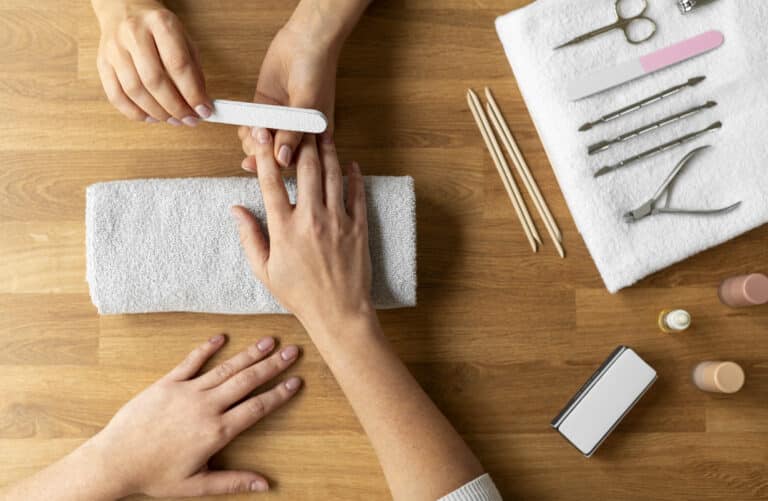A Safe and Simple, Step-by-Step Guide
how to remove acrylic nails at home can save you time and money, but it’s important to do it safely to protect your natural nails. In this guide, we’ll walk you through the best methods, whether you have acetone or not.Though they appear great, acrylic nails can be difficult to remove when it comes time. If done wrong, it could weaken and brittle your natural nails. Using the proper technique, you may securely remove nails at home rather than running to a salon.

This detailed instruction will demonstrate the safest methods for safely removing acrylic nails without harming your natural nails.
How to Remove Acrylic Nails at Home? with Acetone
Things You Will Need:
- 100% pure acetone
- A small bowl
- Cotton balls or pads
- Aluminium foil
- Nail clippers
- A nail buffer or file
- A cuticle pusher or orangewood stick
- Petroleum jelly (Vaseline)
- A soft towel
- Moisturizing cuticle oil
Steps for Acryn Nails Filing the Surface:
To reduce surface gloss from acrylic nails and ensure better absorption by an acetone solution, a nail file should be used to gently buff away all shine using circular strokes until all shine has been eradicated from their top layer. This should facilitate excellent absorption and efficient shine removal from top layers. This method should enable more excellent absorption as well as speedy shine removal!
Soak Cotton Balls in Acetone:
By soaking cotton balls or pads in fully saturated acetone until their fibres are completely wetted, cotton balls may be easily submerged for later use.
Apply Cotton Balls Soaked with Alcohol with Aluminium Foil Wrap:
If you want an added support system when applying nails, secure each fingertip tightly using aluminium foil wrap to ensure they will stay put when painted on. This way, your manicured nails remain safe from movement as soon as you apply paint!
Wait:
Acetone solutions should be applied for at least 15-20 minutes for optimal effects in breaking down acrylic nails effectively. Then, scrape them off using a cuticle pusher or orangewood stick to loosen softened acrylic layers. Once complete, carefully unwrap the foil from nail pads before gently scraping away at softened areas with an orangewood stick until all softened acrylic pieces have been scraped off by hand.
If the acrylic doesn’t come off quickly, rewrap and soak for another 5-15 minutes before trying again.
Buff and Moisturize:
Once all the acrylic has been removed from your nails, buff and moisturize them to smooth down any rough edges or jaggedness that remains.
Hydrate nails and skin with cuticle oil or moisturizer to rehydrate and renew hydration levels.
How to Remove Acrylic Nails at Home? Without Acetone.
What You’ll Need:
- Nail file or buffer
- Bowl of warm, soapy water
- Cuticle pusher or orangewood stick
- Nail oil or moisturizer
Gentle Scrape off Acrylic Coat:
Carefully and patiently use a cuticle pusher to remove any leftover acrylic from your natural nails without further injuring or weakening them. Take your time, as this could do more harm than good for both sets.
Buff and Moisturize Your Nails:
For maximum shine and smooth edges, buff and moisturize your nails regularly to avoid rough corners and any rough patches on their edges.
Apply nail oil or moisturizer to restore moisture balance in the nail beds and skin.
Tips for Safe Nail Removal:
It is wise to avoid peeling or picking at your natural nails as this could damage them over time and result in further problems. Peeling/Picking could tear the nail plate apart and result in additional long-term harm to them.
Don’t Rush:
Take your time when taking off acrylic. Be as gentle as possible while pulling back gently on it from its stickiness.
Hydrate Your Nails:
After removal, make sure your nails and cuticles remain moisturized to restore their health and restore them as much as possible.
Now that you have your tools ready let’s walk through the process.
Method 1:
The Soak-Off Method (most sensible and practical)
Removing acrylic nails without causing too much damage to your natural nails is easiest done this way.
Step 1:
- Cut the acrylic nails.
- Trimming down the acrylic nails as much as feasible will help with nail clippers.
- To prevent discomfort or damage, be careful not to trim too near to your natural nails.
Step 2:
- Organize the top layer.
- Lightly rub off the topcoat of your acrylic nails with a coarse nail file or nail buffer.
- This stage swiftly removes the protective seal, therefore facilitating the removal process.
- Your nails and cuticles to guard your skin from acetone’s dryness and irritation.
Step 3:
- Get ready for the acetone soak.
- Into a small basin, pour one hundred per cent pure acetone.
- Warm the acetone gently by submerging the bowl in an enormous basin of warm water.
- Acetone is highly combustible, so DO NOT microwave it.
Step 4:
- Acetone nail soaking
- Spend 20–30 minutes soaking your fingertips in the acetone dish.
- Cover your hands with a warm towel soaked to hasten the process.
Step 5:
- Gently removing the acrylic.
- Once soaked, carefully push off the softened acrylic using an orangewood stick or cuticle pusher.
- Should the acrylic not be removed fast, soak for another ten minutes and attempt once more
Step 6:
- Buff and smooth your natural nails.
- Smooth out your natural nails and eliminate any last residue with a nail buffer.
Step 7:
- Hydrate and restore your nails.
- To restore moisture, wash your hands with gentle soap, then apply cuticle oil and a thick hand moisturizer.
Note:
- Avoid adding fresh acrylics right away since your nails may feel fragile after the removal of existing ones.
The Foil Wrap Method (Less Messy Alternative) Method 2
Though it uses foil wrapping rather than soaking in a basin, this technique resembles the soak-off technique.
Step 1:
- File and clip the nails.
- Cut back the acrylic nails as much as you can.
- Break the seal by filing off the top layer of the acrylic.
- Apply petroleum jelly over your nails to help avoid acetone’s dryness.
Step 2:
- Ready Acetone-Soaked Cotton.
- Soak a pad or cotton ball entirely in acetone.
- Straightforwardly lay the moistened cotton on your nail.
Step 3:
- Foil Wrapped Nails
- To fix the cotton ball in place, wrap every nail in aluminium foil.
- It accelerates the process of removal by helping to trap heat.
Step 4:
- Wait twenty to thirty minutes.
- For at least 20 to 30 minutes, let the acetone break down the acrylic.
- Wait another ten minutes should the acrylic not be soft enough.
Step 5:
- Eliminate the acrylic.
- Lightly Push off the freed acrylic using a cuticle pusher.
- Never force it; if it refuses, reapply acetone and wait for more.
Step 6:
- Buff and moisturize.
- Smoothie your natural nails using a nail buffer.
- To revive your nails, apply hand cream and cuticle oil.
Note:
What NOT to Do Regarding Removal of Acrylic Nails?
Never Pry or Peel Off Acrylics—This will strip off layers of your natural nail, causing long-term damage. Steer clear of harsh tools like dental floss. While some internet tips call for removing acrylic nails with floss, this can be rather harmful and painful.☆ Always hydrate following removal since acetone dries out your skin and nails.
How Should Your Nails Look After Acrylic Removal?
✔️ Give Your Nails a Break: Before adding fresh acrylics, let them breathe for a minimum of one week.
✔️ Fix weak nails by using a biotin-rich or nail-hardening therapy.
✔️ Massage Cuticle Oil Daily helps to avoid dryness and maintains healthy nails.
✔️ Eat Nail-Friendly Foods: Incorporate in your diet biotin-rich foods including eggs, almonds, and spinach for better nails.
Thoughts on Final Matters
Removing acrylic nails at home doesn’t have to be complicated. If you take them off patiently and correctly, you can safely remove them.
The Optimal Approach to Minimal Damage Acetone Soak-off ✅ Quickest Approach? Foil wrap technique: most crucial step? Hydrating following removal
Knowing how to securely remove acrylic nails today, which technique will you try? Tell us in the comments!
FAQ
Can We take off acrylic nails at home?
Yes, you can take off acrylic nails at home safely.
How do I unsafely soak off acrylic nails at home?
Soaking the nails in acetone is one of the most optimal approaches to dissolving acrylic nails without damage. The soaking method helps break apart the acrylics, which allows for their removal painlessly
Are acrylic nails removable with vinegar or lemon juice?
Although acrylic nails will be looser, this approach is more time-consuming and requires extraordinary patience.
What should be done when there are weak nails post-recovery?
Treat nails with a strengthening treatment and apply cuticle oil. Avoid applying acrylics or gel polish simultaneously because your nails need time to recuperate.
How frequently should acrylic nails be put on break?
For optimal results, it’s best to take a break every 2-3 months to let your nails rest and strengthen.
Is there pain felt while removing the acrylic nails at home?
When done correctly, it is painless. If discomfort begins to occur, stop and try soaking your nails for longer instead.
how long can acrylic nails last?
Acrylic nails last upto 6 to 8 weeks.
how to remove acrylic nails without acetone?
Yes you can remove acrylic nails without acetone by soaking them in warm and soapy water for 20 t0 30 minutes. You can also try Dental Floss to slide them off carefully
how long do you soak acrylic nails in acetone?
Acrylic nails can be soaked upto 15 minutes until they softened.
